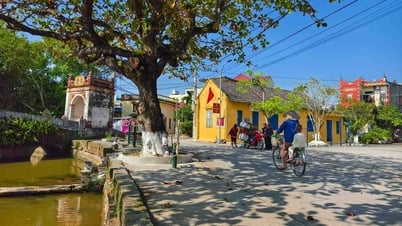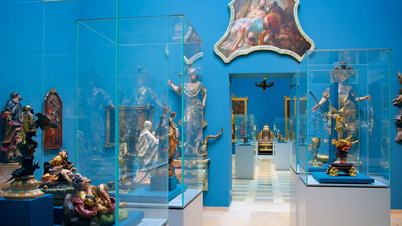After nearly 2 years of restoration and reconstruction, the national relic Hai Van Quan has basically completed important items to almost its original state as a "defensive citadel" of the Nguyen Dynasty, and is expected to welcome visitors again at the end of 2023.
On August 13, Mr. Huynh Dinh Quoc Thien, Director of Da Nang Museum, said that the functional departments of the two localities of Da Nang City and Thua Thien - Hue are making efforts to complete the restoration work at the national relic Hai Van Quan . The project is expected to be completed in October 2023, then plan to operate and welcome tourists . Important items such as Hai Van Quan, headquarters, arsenal, fortress locations, stone walls, walkways, etc. have basically completed the restoration.

Overview of the project to preserve, restore, renovate and promote the value of Hai Van Quan national relic with an area of about 6,500m2, total investment of more than 42 billion VND

According to the project, the Hai Van Quan "defensive rampart" system will be restored according to the original vestiges of the Nguyen Dynasty, during the reign of King Minh Mang.

Hai Van Quan's gate foundation was replaced with Thanh stone; the Thanh stone gate system, the upper wall... were built with bricks.

The headquarters building and the arsenal (3 rooms) were restored according to archaeological remains and documentary photos.

The walkways and walls of the relic were restored, replacing the stone-paved gate floor, stone gate system, brick walls... the inside of the citadel was built with stone.

The gate at Hai Van Quan relic is an important item that has been restored.

Speaking to Thanh Nien reporter, Mr. Bui Van Khuyen (photo), Institute of Construction Science and Technology - Central Branch, said that so far, the Hai Van Quan restoration items have been 95% completed, but some sections of the wall built with orphaned stones cannot be constructed because of the electric poles. "We will strive to complete the project before the rainy season and hand it over in 2023," Mr. Khuyen said.

To build the wall, the construction unit carefully selected each orphaned stone of the appropriate size to ensure aesthetics.

From the citadel wall looking down Hai Van pass. These items have been restored or rebuilt according to documentary images.

The paving stones measuring 40x80 cm were numbered by the construction workers to re-pave the floor in the same position as before.

Some bunkers built during the anti-French and anti-American wars in the Hai Van Quan relic area are preserved with the purpose of connecting the history between the war periods.

The paved road connecting the Hai Van Quan "defensive ramparts" has been planted with more trees.

Standing on the wall of Hai Van Quan, you can see the whole of Lang Co Bay and Da Nang Bay.

The project to preserve, restore and promote the value of Hai Van Quan relic when put into operation and exploitation will contribute to the socio-economic development of Thua Thien-Hue province and Da Nang city.
Hai Van Quan was built at an altitude of 490m above sea level, in the 7th year of Minh Mang (1826). This is not only a gateway project on the north-south highway to control ships entering and leaving Da Nang Bay, but also an important military defense complex with a system of ramparts, cannon forts..., known as the "throat" of Thuan Quang region.
This citadel is located on the only highway from the capital Hue to Quang Nam and vice versa, and is known as "the most majestic pass in the world".
Hai Van Quan relic site was once "abandoned" and showed signs of deterioration for a long time, located in the overlapping area between Da Nang City and Thua Thien - Hue Province. In April 2017, leaders of the Department of Culture and Information of Da Nang City and Thua Thien - Hue Province "joined hands" to restore it, when Hai Van Quan was recognized as a national relic.
(According to Thanh Nien, August 13, 2023)
Source



![[Photo] Panorama of the Opening Ceremony of the 43rd Nhan Dan Newspaper National Table Tennis Championship](https://vphoto.vietnam.vn/thumb/1200x675/vietnam/resource/IMAGE/2025/5/19/5e22950340b941309280448198bcf1d9)
![[Photo] Close-up of Tang Long Bridge, Thu Duc City after repairing rutting](https://vphoto.vietnam.vn/thumb/1200x675/vietnam/resource/IMAGE/2025/5/19/086736d9d11f43198f5bd8d78df9bd41)
![[Photo] President Luong Cuong presents the 40-year Party membership badge to Chief of the Office of the President Le Khanh Hai](https://vphoto.vietnam.vn/thumb/1200x675/vietnam/resource/IMAGE/2025/5/19/a22bc55dd7bf4a2ab7e3958d32282c15)

![[Photo] General Secretary To Lam attends the conference to review 10 years of implementing Directive No. 05 of the Politburo and evaluate the results of implementing Regulation No. 09 of the Central Public Security Party Committee.](https://vphoto.vietnam.vn/thumb/1200x675/vietnam/resource/IMAGE/2025/5/19/2f44458c655a4403acd7929dbbfa5039)



























![[Photo] Prime Minister Pham Minh Chinh inspects the progress of the National Exhibition and Fair Center project](https://vphoto.vietnam.vn/thumb/1200x675/vietnam/resource/IMAGE/2025/5/19/35189ac8807140d897ad2b7d2583fbae)























































![[VIDEO] - Enhancing the value of Quang Nam OCOP products through trade connections](https://vphoto.vietnam.vn/thumb/402x226/vietnam/resource/IMAGE/2025/5/17/5be5b5fff1f14914986fad159097a677)



Comment (0)